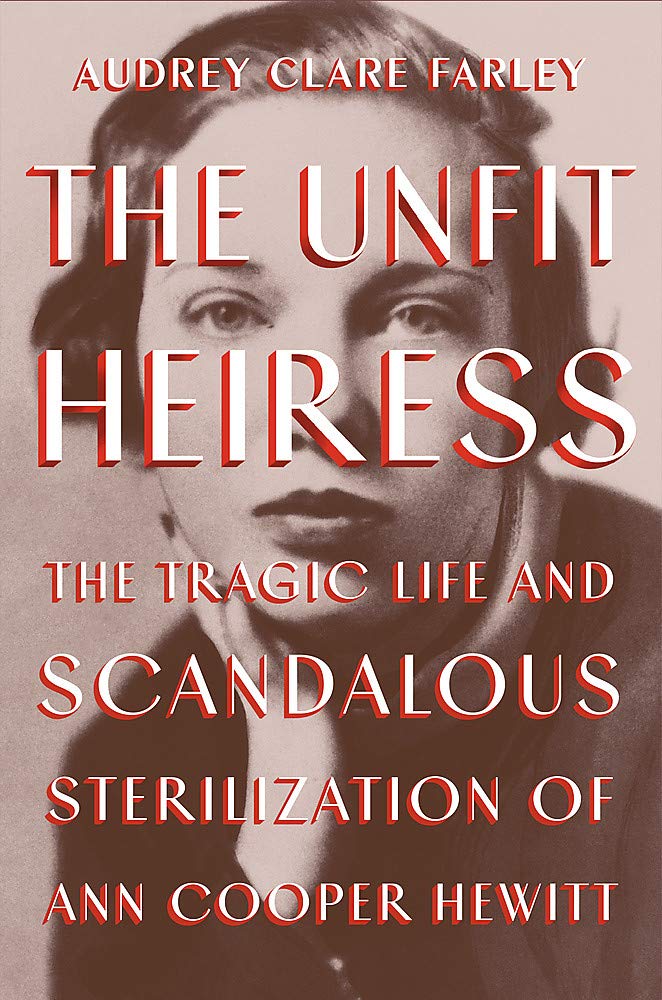What does it mean to be “unfit” for motherhood? In the battle for reproductive rights, can we forgive the women who side against us? And can we forgive our mothers if they are the ones who inflict the deepest wounds?
In 1934, aided by a California eugenics law, the socialite Maryon Cooper Hewitt had her “promiscuous” daughter declared feeble-minded and sterilized without her knowledge. She did this to deprive Ann of millions of dollars from her father’s estate, which contained a child-bearing stipulation. When a sensational court case ensued, the American public was captivated. So were eugenicists, who saw an opportunity to restrict reproductive rights in America for decades to come.
The following is an excerpt from Chapter 2 of The Unfit Heiress: the Tragic Life and Scandalous Sterilization of Ann Cooper Hewitt by Audrey Clare Farley—a story of eugenics and women’s reproductive rights framed by the sordid court battle between Ann Cooper Hewitt and her socialite mother:

After several more days of testimony, most of which rehashed the well-known content of previously filed affidavits, the 12 people in the jury box appeared to be stumped. One side asserted Ann’s innocence and the other her deviance. One asserted Ann’s intelligence and the other her imbecility. One associated sterilization with lawlessness and the other with order.
But these individuals’ opinions were never solicited, as Judge Tuttle dismissed the case. “This is a useless expenditure of public funds,” he declared. “The prosecution has completely failed to make a case against the defendants. The evidence is simply not meritorious enough to be given to a jury.” According to the judge, sterilization in California was not a crime; therefore, mayhem had not been committed, and there had been no conspiracy to commit it.
Both doctors wept from their seats at the defense table, while Fourtner vehemently shook his head and declared the court’s action “all wrong.” Ann did not betray a single emotion. When the gavel struck, the heiress simply stood and walked out of the courthouse. Her driver was waiting on the street, ready to speed her away from reporters demanding her reaction to Tuttle’s move. But once the vehicle turned the corner, she stomped her feet and began to scream.
In a written opinion, Tuttle elaborated that there was no proof of any bad faith in the case. “The most that can be said,” he claimed, “is that there were suspicions and innuendoes, which certainly would not sustain a verdict against defendants.”
The judge disagreed with the prosecution that the timing of Ann’s sterilization (occurring within a year of her 21st birthday) was meaningful. He claimed, “The law makes no distinction between a case where the minor is 19 years of age and where the minor is five years of age.” From a legal perspective, “both are under the identical disability so far as consent to an operation is concerned, and the parents or guardian have the same power to consent in each case.” If this reality leads to situations that are unjust, “then the remedy is with the legislature and not the courts.”
Brady and Fourtner immediately implored the court of appeals to reopen the case, claiming Tuttle had conducted the trial in “a disorderly fashion.” One week later, on August 28, 1936, their appeal was denied. Popenoe and Gosney, who had been quietly following the case in the newspapers, slapped each other’s backs. On August 29, Popenoe wrote to Golden, “May I join my congratulations to the flood of them which I am sure you have been receiving, for your smashing victory which the appellate court seems now to have made complete.”
Golden accepted this praise with a note explaining that though the case wasn’t fully closed, he was confident he’d prevailed. “Since you wrote, the District Attorney has made an application to the Supreme Court for Writs similar to those which were denied by the Appellant Court,” Golden explained. “But in my opinion, the Supreme Court will likewise deny his application.”
He was right. Later that day, the California Supreme Court refused to reopen the mayhem case.
There was not a single protest, riot or even op-ed written to criticize the decision. In fact, locals expressed agreement with the use of surgery to protect traditional family values. The author of a weekly column in the Los Angeles Times Sunday Magazine noted an increase in public support for sterilization after the trial. Fred Hogue commented, “I find there is a growing interest in a more extended enforcement of State sterilization laws. This increasing interest comes chiefly from women, most of whom are mothers.”
Hogue claimed to have received many letters from women confiding their sympathies and reporting concerns about certain women in their community who had no business rearing children. The writer published some of these letters, such as one from a 31-year-old reader who wrote, “I am amazed in this day and age right-thinking people let imbeciles have children. Why, and when will a law be passed to stop this?”
Emboldened by the case’s outcome, Popenoe sent hundreds of copies of the court decision to private physicians around the world. So did F. O. Butler, the director of the Sonoma State Home. Judge Tuttle’s ruling had basically authorized sterilization as a medical solution to domestic environments deemed lacking.
In doing so, the ruling lessened the burden of proof to demonstrate a woman’s unfitness for motherhood, while also distancing sterilization efforts from the race-based programs developing in Germany. At the time of the trial, authorities acting on behalf of the state had to produce evidence of disease or degeneracy based on one’s family tree or intelligence tests, albeit very skewed ones. Going forward, they only needed to establish that a woman had a morally bankrupt mother; it followed that she would become such a mother herself.
Popenoe wondered if the shift in criteria would actually help authorities to focus on working-class and minority women, such as Mexican Americans, who often had no apparent disabilities but were long believed to be reckless breeders. Just two years before Ann’s case made headlines, he’d observed that such women in California had, on average, 5.2 living children, few of whom were of “superior quality.” With a new rubric for establishing feeble-mindedness, authorities could simply cite a minor offense, such as truancy, and the number of one’s siblings to make a case for sterilization.
Also, in denying that mayhem had been committed, the case might have actually affirmed individuals’ right to sexual pleasure, Popenoe thought. Prior to 1936, legal scholars had struggled to apply the definition of mayhem (the “unlawful and malicious removal of a member of a human being or the disabling or disfiguring thereof or rendering it useless”) in sterilization cases because they couldn’t pinpoint the primary purpose of the female sex organs. If the organs’ primary purpose was reproduction, these scholars reasoned, then a case of mayhem could indeed be made. However, if the organs’ primary purpose was gratification of sexual desires, then there was no case for mayhem. Which was it? Though Golden hadn’t specifically intervened in this debate during the trial proceedings, his victory for the defense suggested that pleasure was a right of all and procreation a privilege of the certain few.
This meant that now more than ever, eugenicists needed to emphasize societal interests over individual ones. Rather than simply claiming that sterilization was protective or even curative, they needed to stress the impact to society when defective individuals reproduced.
But for all its immediate and potential impact, there was one thing the mayhem trial of 1936 didn’t do: let Maryon Cooper Hewitt off the hook for the criminal charges brought against her. In fact, after the case against the two doctors was dismissed in August, the San Francisco district attorneys were more determined than ever to extradite the woman from New Jersey to stand trial on conspiracy to commit mayhem. As far as Brady and Fourtner were concerned, Ann’s mother still needed to pay for her odious crime.
Excerpted from The Unfit Heiress: The Tragic Life and Scandalous Sterilization of Ann Cooper Hewitt by Audrey Clare Farley. Copyright © 202 by Audrey Clare Farley. Reprinted with permission of Grand Central Publishing. All rights reserved.
Up next:





